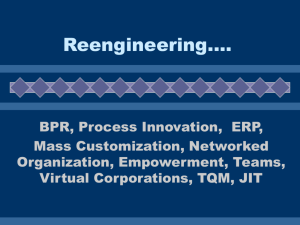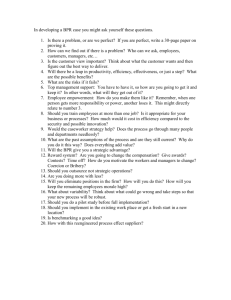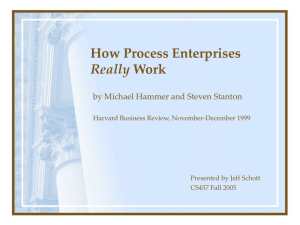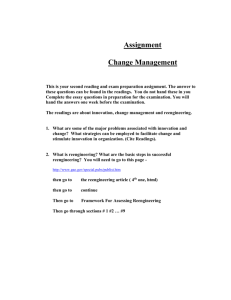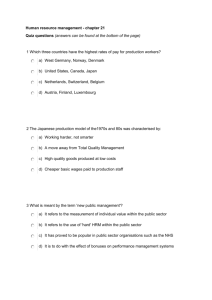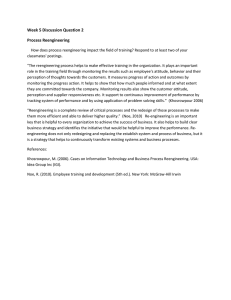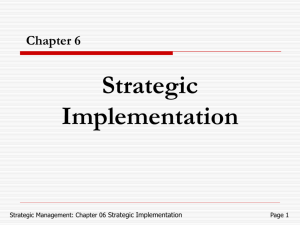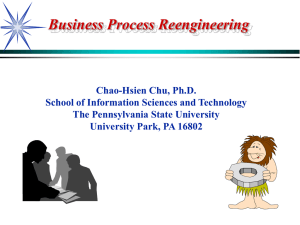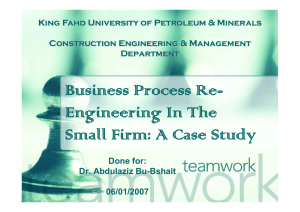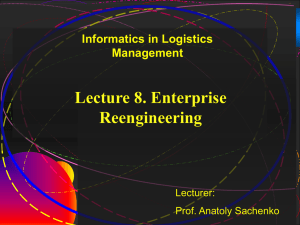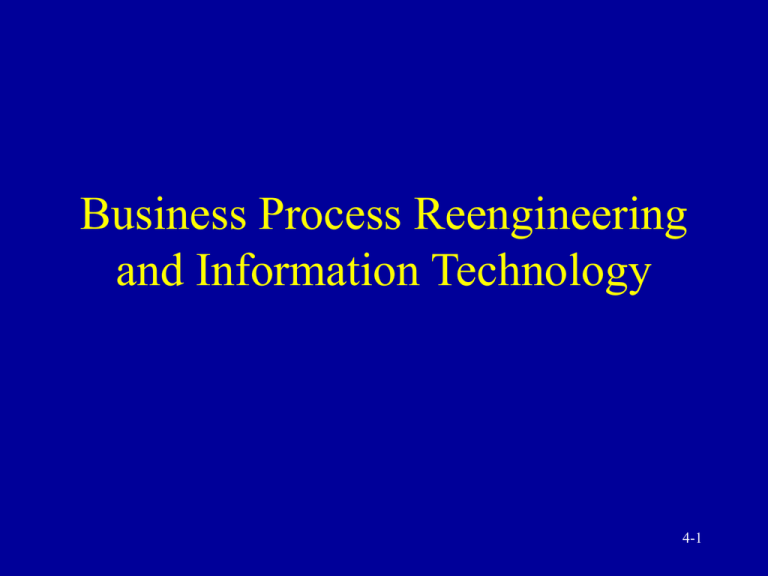
Business Process Reengineering
and Information Technology
4-1
Basic Concepts
•
•
•
•
•
Business process
Value added
Business Process Reengineering (BPR)
Demand chain
Supply chain
4-2
Basic Concepts
•
•
•
•
Supply chain management
Extended supply chain
Networked organization
Organizational transformation
4-3
The Need for BPR
•
•
•
•
•
•
•
Customers
Competition
Change
Techniques lag behind technology
Problem of the stovepipe
Fragmented piecemeal systems
Integration
4-4
The Principles of BPR
and The Role of IT
• Characteristics of BPR
• Methodologies and frameworks for BPR
• Enabling role of IT
4-5
Characteristics of Business
Process Reengineering
•
•
•
•
•
Several jobs are combined into one
Employees make decisions
Steps in business process: natural order
Process may have multiple versions
Work is performed where it makes the most
sense
4-6
Characteristics of Business
Process Reengineering
• Controls, checks, other nonvalue-added
work is minimized
• Reconciliation is minimized - minimize
external contact points
• Hybrid centralized / decentralized operation
is used
• A single point of contact is provided for the
customer
4-7
Business Process Reengineering
and
Restructuring the Organization
• Redesign of processes
• From mass production to mass
customization
• Cycle time reduction
• Restructuring organizations
4-8
The Networked Organization
• Structure of networked organizations
• Empowerment
– IT / empowerment relationship
• Teams
4-9
Virtual Corporations
A virtual corporation is an organization
composed of several business partners
sharing costs and resources for the purpose
of producing a product or service.
4-10
Virtual Corporations
Major Attributes
•
•
•
•
•
•
•
Excellence
Utilization
Opportunism
Lack of borders
Trust
Adaptability to change
Technology
4-11
Total Quality Management
and Reengineering
• Rate of change
• TQM: continuous improvement
• Reengineering: dramatic improvement
4-12
TQM versus Reengineering
4-13
Implementing Reengineering
• Redesign
• Retool
• Reorchestrate
4-14
Tools for BPR
•
•
•
•
•
Simulation
Flow diagrams
Work analysis
Application development
Workflow software
4-15
Reorchestrate:
Organizational Change
•
•
•
•
•
•
Leadership
Corporate values
Cultural change
Incentives
Accountability
Zeal
4-16
Reorchestrate:
Organizational Change
•
•
•
•
Communication
Ambiguity
Obstacles to change
Celebrate success
4-17
Implementation Issues
• Continuous evaluation
• Eliminating jobs
4-18
Continuous Evaluation
•
•
•
•
Is reengineering truly transformational?
Will reengineering improve customer relations?
Has reengineering cut across the organization?
Is information technology playing a integral role
in the reengineering solution?
• Does it hurt?
4-19
When to Use BPR?
•
•
•
•
Failure rate as high as 75-85%
Improperly aligned BPR and IT
Expensive
Organizational resistance
4-20
Managerial Issues
•
•
•
•
•
•
•
Ethical issues
BPR implementation
Incremental improvement programs
BPR tools
Role of IT
Failures
TQM and BPR
4-21
Copyright 1999 John Wiley & Sons, Incorporated. All rights
reserved. Reproduction or translation of this work beyond that
permitted in Section 117 of the 1976 United States Copyright Act
without the express written permission of the copyright owner in
unlawful. Request for further information should be addressed to
the Permissions Department, John Wiley & Son, Inc. Adopters of
the textbook are granted permission to make back-up copies for
his/her own use only, to make copies for distribution to student of
the course the textbook is used in, and to modify this material to
best suit their instructional needs. Under no circumstances can
copies be made for resale. The publisher assumes no
responsibility for errors, omissions, or damages, caused by the use
of these programs or from the use of the information contained
herein.
4-22


